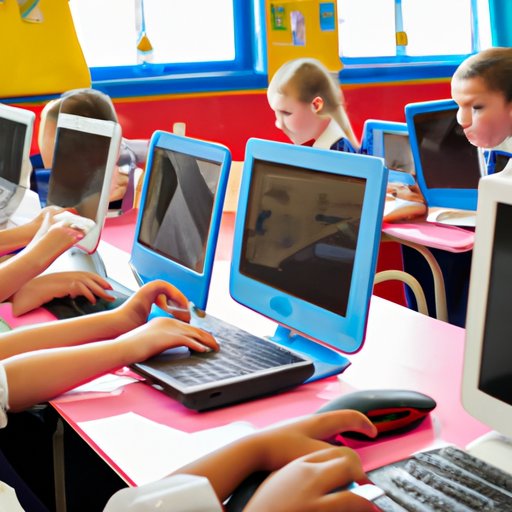Introduction
The use of technology in education has been steadily on the rise for the past decade, with more and more schools adopting digital classrooms, leveraging artificial intelligence (AI) to improve educational institutions, and utilizing video conferencing to create collaborative learning experiences. This article will explore how technology is transforming education and the potential benefits it can bring.

Digital Classrooms: Examining the Benefits of Technology in Education
Digital classrooms are becoming increasingly popular in educational institutions around the world as a way to improve student outcomes and reduce costs. These classrooms typically feature interactive whiteboards, high-resolution projectors, and computers with internet access, allowing students to access online resources and collaborate with their peers.
One of the main advantages of using digital classrooms is that they provide an engaging learning environment for students. Not only do they allow teachers to easily share information with their classes, but they also provide an array of interactive activities that can help keep students engaged and motivated. For example, digital classrooms can be used to facilitate group discussions or debates, allowing students to practice their communication skills and develop critical thinking abilities.
In addition to providing an engaging learning environment, digital classrooms can also help improve student outcomes. With access to online resources, students can quickly and easily search for information related to the topics being discussed in class. This can save time and ensure that students are able to stay on track with their studies. Additionally, digital classrooms can be used to track student progress, giving teachers a better understanding of where each student stands and what needs to be done to help them succeed.
Exploring How Technology is Transforming Traditional Learning Models
Traditional learning models typically involve lectures, textbooks, and assignments. While these models are still widely used, technology is beginning to change the way education is delivered. For example, online courses are becoming increasingly popular, allowing students to access course materials from anywhere in the world. Additionally, virtual reality (VR) and augmented reality (AR) are being used to create immersive learning experiences that can help students better understand complex concepts.
With the rise of technology, educational institutions are also beginning to leverage data to personalize instruction and tailor curriculums to individual student needs. This allows teachers to better assess student performance and adjust lessons accordingly, providing a more effective learning experience for every student.

How Technology is Enhancing Student Engagement and Retention
Technology can also be used to enhance student engagement and retention. By introducing gamification into the classroom, teachers can make learning fun and enjoyable for students, encouraging them to stay focused and motivated. Additionally, technology can be used to create personalized learning paths for each student, ensuring that everyone has the opportunity to reach their full potential.
Technology can also be used to improve student retention rates. For example, adaptive learning platforms can be used to provide personalized support to struggling students, while analytics tools can be used to identify at-risk students and intervene before they drop out. Additionally, automated systems can be used to remind students of upcoming assignments and tests, helping them stay on track with their studies.

The Impact of AI and Automation on Educational Institutions
AI and automation are having a profound impact on educational institutions. AI can be used to quickly analyze large amounts of data and generate insights that can be used to inform decisions and improve student outcomes. Additionally, AI can be used to automate repetitive tasks such as grading and attendance tracking, freeing up teachers to focus on more important aspects of teaching.
However, there are some potential risks associated with the use of AI and automation in education. For example, automated systems can be biased based on the data they are trained on, resulting in unfair outcomes for certain groups of students. Additionally, there is a risk that automation could lead to job losses, as more roles become automated.
Leveraging Video Conferencing to Create Collaborative Learning Experiences
Video conferencing is another way in which technology can be leveraged to improve education. By allowing students to participate in virtual meetings and lectures, video conferencing can create an immersive learning experience and enable collaboration between students from different locations. Additionally, video conferencing can be used to facilitate discussions and debates, allowing students to practice their communication skills in a safe and secure environment.
There are several successful examples of video conferencing initiatives in education. For example, the University of California San Diego has implemented a “virtual classroom” program, which allows students to attend lectures remotely. Additionally, the University of Wisconsin–Madison has launched a “Global Classroom” initiative, which enables students to collaborate with peers from other countries.
Conclusion
In conclusion, technology is revolutionizing education, enabling educators to create engaging learning environments and leverage data to personalize instruction. Digital classrooms, AI, and video conferencing are just some of the ways in which technology is transforming education and improving student outcomes. We encourage readers to explore the potential of technology in their schools and take advantage of the opportunities it provides.
(Note: Is this article not meeting your expectations? Do you have knowledge or insights to share? Unlock new opportunities and expand your reach by joining our authors team. Click Registration to join us and share your expertise with our readers.)
